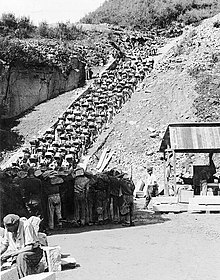The same thing is going on in the USA........another one i truncated greatly...im in 2025 now.........10 year blog..............as the civil right's groups and us fed gov........have done nothing but humiliate me and lie to me..
Concentration and labor camps
The Third Reich first used concentration camps as places of unlawful incarceration of political opponents and other "enemies of the state". Large numbers of Jews were not sent there until after Kristallnacht in November 1938.[172]Although death rates were high, the camps were not designed as killing centers.[173] After war broke out in 1939, new camps were established, some outside Germany in occupied Europe.[174] In January 1945, the SS reports had over 700,000 prisoners in their control, of which close to half had died by the end of May 1945 according to most historians.[175] Most wartime prisoners of the camps were not Germans but belonged to countries under German occupation.[176] It is estimated that the Germans established over 42,000 detention sites throughout Europe, including ghettos, concentration camps, prisoner-of-war camps, labour camps, and extermination camps.[177]
After 1942, the economic functions of the camps, previously secondary to their penal and terror functions, came to the fore. Forced labour of camp prisoners became commonplace and companies utilized their cheap labour.[172] The guards became much more brutal, and the death rate increased as the guards not only beat and starved prisoners, but killed them more frequently.[176] Extermination through labour was a policy—camp inmates would literally be worked to death, or to physical exhaustion, at which point they would be gassed or shot.[178] The Germans estimated the average prisoner's lifespan in a concentration camp at three months, due to lack of food and clothing, constant epidemics, and frequent punishments for the most minor transgressions.[179] The shifts were long and often involved exposure to dangerous materials.[180]
Prisoner transportation between camps was often carried out in freight cars with the prisoners packed very tightly. Long delays would take place, with the prisoners confined in the cars on sidings for days.[181] In mid-1942 labor camps began requiring newly arrived prisoners to be placed in quarantine for four weeks.[182] Some camps tattooed prisoners with an identification number on arrival, but not all did.[183] Prisoners wore colored triangles on their uniforms, with the color of the triangle denoting the reason for their incarceration. Red signified a political prisoner, Jehovah's Witnesses had purple triangles, "asocials" and criminals wore black or green. Badges were pink for gay men and yellow for Jews.[184] Jews had a second yellow triangle that was worn with their original triangle, with the two forming a six-pointed star.[185][186]
Ghettos
After invading Poland, the Germans established ghettos in the incorporated territories and General Government to confine Jews.[134] The ghettos were formed and closed off from the outside w

No comments:
Post a Comment